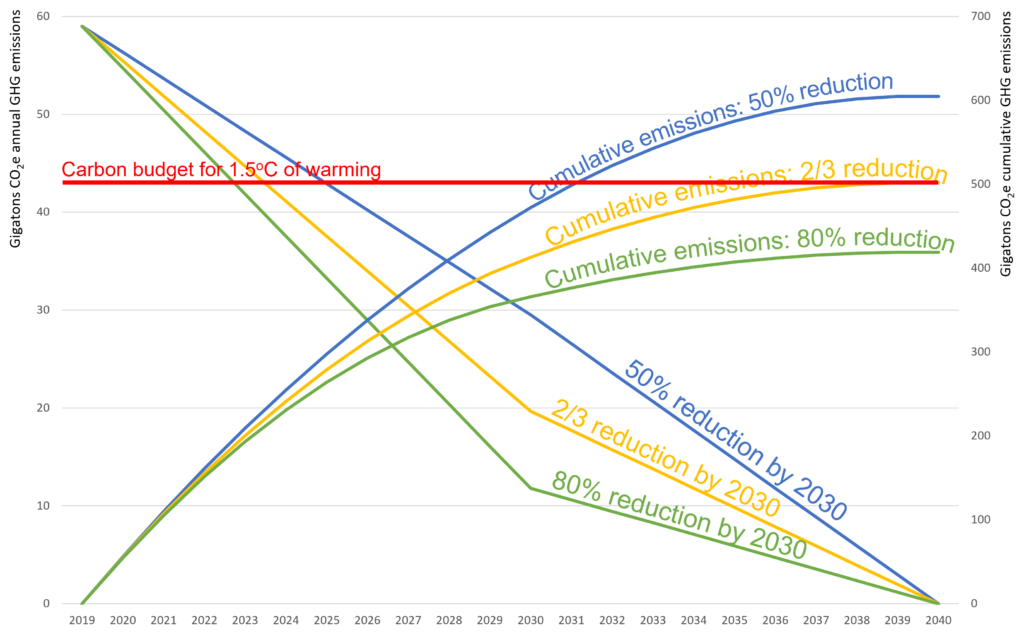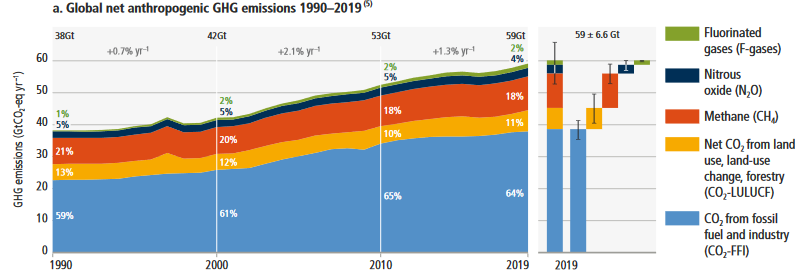
Whither Carbon Budget?
By: Chandu Visweswariah
The recent Intergovernmental Panel on Climate Change (IPCC) AR6 (Assessment Report 6) Synthesis Report states that we have a remaining carbon budget of 500 gigatons or 500 billion metric tons of CO2 equivalent. What does this mean in practical terms?
A carbon budget at an instant of time means that the cumulative emissions from that instant until eternity should not exceed the budget. The consensus among the world’s climate scientists is that the earth is likely to warm by 1.5oC when humanity’s cumulative greenhouse gas (GHG) emissions reach 500 gigatons, with the accounting starting on January 1, 2020. If we exceed the budget, we are likely to blow past 1.5 degrees of warming, and the planet is likely to continue to warm even faster and face more catastrophes.
How fast are we hurtling toward the limit of our carbon budget? Wickedly fast! We have been increasing GHG emissions year-over-year; we now emit about 59 gigatons per year. At this rate, our budget will be exhausted in 8.5 years.
The recent sordid history of mankind’s GHG emissions leading up to a total of 59 gigatons in 2019 can be found in the IPCC’s “Mitigation of Climate Change” Working Group III report and is shown below.

Sadly, GHG emissions continue to rise, and our “drawdown” phase has not yet begun.
Let us examine our carbon budget in the face of three different future scenarios:
- Scenario A: 50% GHG reduction between 2020 and 2030, net zero by 2040 (as per our CURE100 master plan);
- Scenario B: 2/3 (or 67%) GHG reduction between 2020 and 2030, net zero by 2040; and
- Scenario C: 80% GHG reduction between 2020 and 2030, net zero by 2040 (which is the mission adopted by our sister environmental organization, Bedford2030).
The three scenarios are depicted in the headline illustration of this blog. The left vertical axis shows annual worldwide emissions in gigatons of CO2e and the three downward lines illustrate the three scenarios. The right axis shows cumulative GHG emissions since 2020. The conclusions are pretty obvious.
- Scenario A (50% reduction) blows the carbon budget (red line) around 2031, and therefore will almost certainly lead to “overshoot” of our 1.5oC warming target. According to the IPCC AR6 Synthesis Report, additional warming of 0.45oC can be expected for each 1,000 gigatons of CO2. Therefore, the nominal amount of overshoot will be 0.05oC.
- Scenario B (2/3 reduction) just about stays within our carbon budget! So even though Scenario B achieves net zero at the same time as Scenario A, the faster reduction in this decade enables it to come within budget.
- Scenario C (80% reduction) gives us a cushion of about 80 gigatons. Such a cushion could be extremely valuable, e.g., if our decarbonizing progress runs into heavy weather (no pun intended). Also, impacts such as permafrost methane leaks (due to melting of permafrost) and fossil methane leaks (due to a combination of seismic activity and melting permafrost) have not been fully accounted in the carbon budget, so it is extremely useful to have a cushion. And if the cushion is not required, it will improve the probability of staying within 1.5oC of warming.
The take-aways from this blog are: (a) 50% GHG reduction by 2030 is no longer sufficient; we require at least 2/3 reduction. (b) The IPCC AR6 synthesis report is very clear that every increment of global warming above 1.5oC will “intensify multiple and concurrent hazards.” (c) The IPCC report also says that “the choices and actions implemented in this decade will have impacts now and for thousands of years,” which can clearly be seen from our carbon budget analysis.
Staying within this carbon budget means a drastic and accelerated decarbonization plan for the world. What if we are able to live within this budget? That would buy us a measly 50% probability of limiting warming to 1.5oC, since that is how the budget of 500 gigatons is derived. Since when is it acceptable that our ridiculously-ambitious-absolutely-best-case-scenario is a 50-50 bet on the planet?
If you find it alarming that we are on track to blow our carbon budget by the end of the decade, you can help. Stop burning fossil fuels and tell our elected officials to ban fossil fuels on a timetable (more about this in a future blog) – there is no other way out of this climate hell. Help us translate the life-altering importance of these numbers into meaningful local climate action.
[Author’s note: you can get a short and digestible summary of the recent IPCC report from our most recent newsletter here.]

